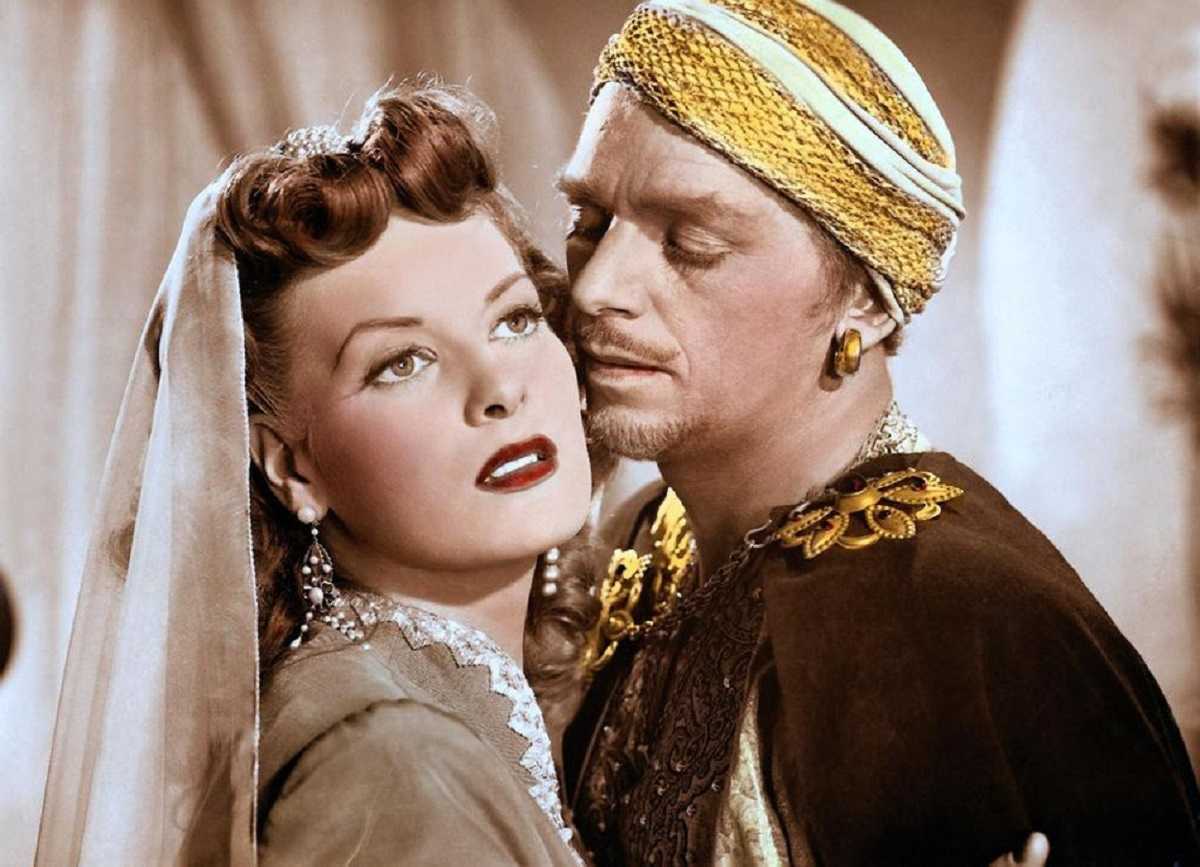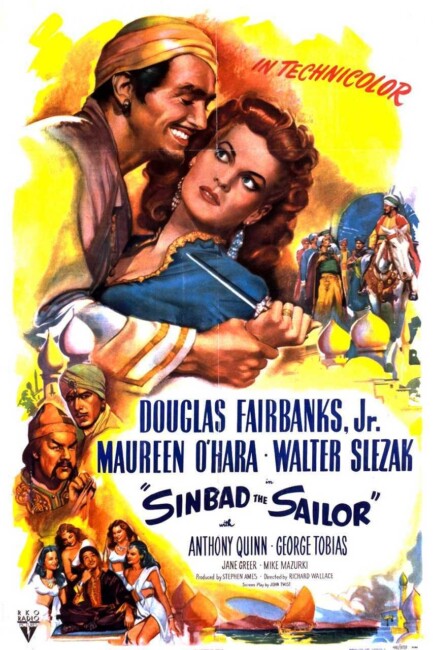USA. 1947.
Crew
Director – Richard Wallace, Screenplay – John Twist, Story – John Twist & George Worthing Yates, Producer – Stephen Ames, Photography – George Barnes, Music – Roy Webb, Special Effects – Vernon L. Walker & Harold Wellman, Makeup – Gordon Bau, Art Direction – Carroll Clark & Albert S. D’Agostino. Production Company – RKO Radio Pictures.
Cast
Douglas Fairbanks Jr (Sinbad), Maureen O’Hara (Shireen), Walter Slezak (Abdul Melik), Anthony Quinn (Mafi, The Emir of Daibul), George Tobias (Abbu), Alan Napier (Aga)
Plot
Sinbad tells the wildly exaggerated stories of his exploits before a group of beggars. They are bored, having heard all of the stories before, and so Sinbad tells them the untold story of his eighth voyage. Sinbad found the ship Prince Ahmed adrift at sea, its crew dead from having drunken poisoned water. Aboard the ship, he found a map of the legendary island of Dariabah, which reputedly held the treasure of Alexander the Great, but the map mysteriously vanished when his back was turned. Attempting to stay alive, Sinbad became caught between the cruel Emir of Daibul, a secret assassin and the beautiful concubine Shireen, all wanting to find the way to Dariabah and believing that he held the clues.
The great Douglas Fairbanks became famed for his roles as a swashbuckling hero in films of the silent era such as The Mark of Zorro (1920), The Three Musketeers (1921), Robin Hood (1922), The Black Pirate (1926) and The Iron Mask (1929). One of Fairbanks’s best films was The Thief of Bagdad (1924), which became the first Arabian Nights adventure on screen (even if it was an original work that was merely drawing on the generalised milieu rather than adapting any of the traditional Arabian Nights tales). It created the template for all subsequent Arabian Nights adventures on screen. (For a more detailed overview of the genre see Arabian Nights Fantasy).
Douglas Fairbanks died in 1939. His son Douglas Fairbanks Jr had had a minor acting career beginning in the 1910s. Fairbanks Jr gained a modest star in the 1930s and appeared in a number of high profile films including Little Caesar (1931) and Gunga Din (1939), and a few of the types of the swashbucklers his father was famed for with The Prisoner of Zenda (1937) and The Corsican Brothers (1941) but never rose to the level of superstardom his father did. Sinbad the Sailor was an effort clearly made to cast Douglas Fairbanks Jr in his father’s footsteps and recreate something of The Thief of Bagdad – there had been a renewed interest in the Arabian Nights fantasy in the 1940s after the beautifully lavish colour remake of The Thief of Bagdad (1940).
Sinbad the Sailor was the first screen version of Sinbad, although the character had earlier made a minor appearance in Arabian Nights (1942) (played by no less than Shemp Howard of The Three Stooge fame) and in short cartoon form in Sinbad the Sailor (1935) from Walt Disney associate Ub Iwerks and Popeye the Sailor Meets Sinbad the Sailor (1936).

As a Sinbad film, Sinbad the Sailor proves to be a real oddity. One comes to it after having seen Ray Harryhausen’s magnificent versions of the Sinbad story with The 7th Voyage of Sinbad (1958) and The Golden Voyage of Sinbad (1973). By contrast, this is a Sinbad film without fantasy or magic. Everything takes place in a talk-heavy plot with not a lot of action. The results are like a fish out of water. Certainly, the film is not unentertaining in its stagebound effects but it is strange to see a Sinbad that emphasises talk instead of action.
For all the film’s Technicolor spectacle, the sets and models are sometimes appallingly flat and obvious and in poor perspective. The fights get to be so silly that it often looks as though they forgot to choreograph in the custard pies. Douglas Fairbanks Jr bounces and leaps around like a manic leprechaun, as though he has more of a chance of overcoming his opponents by grinning them to death then actually fighting them – although the extravagant cheer does eventually catch on after awhile.
Elsewhere, there are some well drawn characters who are fitted up with some nicely formal, ornate dialogue. Particularly good is Walter Melik playing the ambiguous character of the barber and also the wisely Aga. The low comedy relief with the sidekick character played by George Tobias proves irritating. One cannot go without mentioning the breath-taking beauty of Maureen O’Hara.
Trailer here


